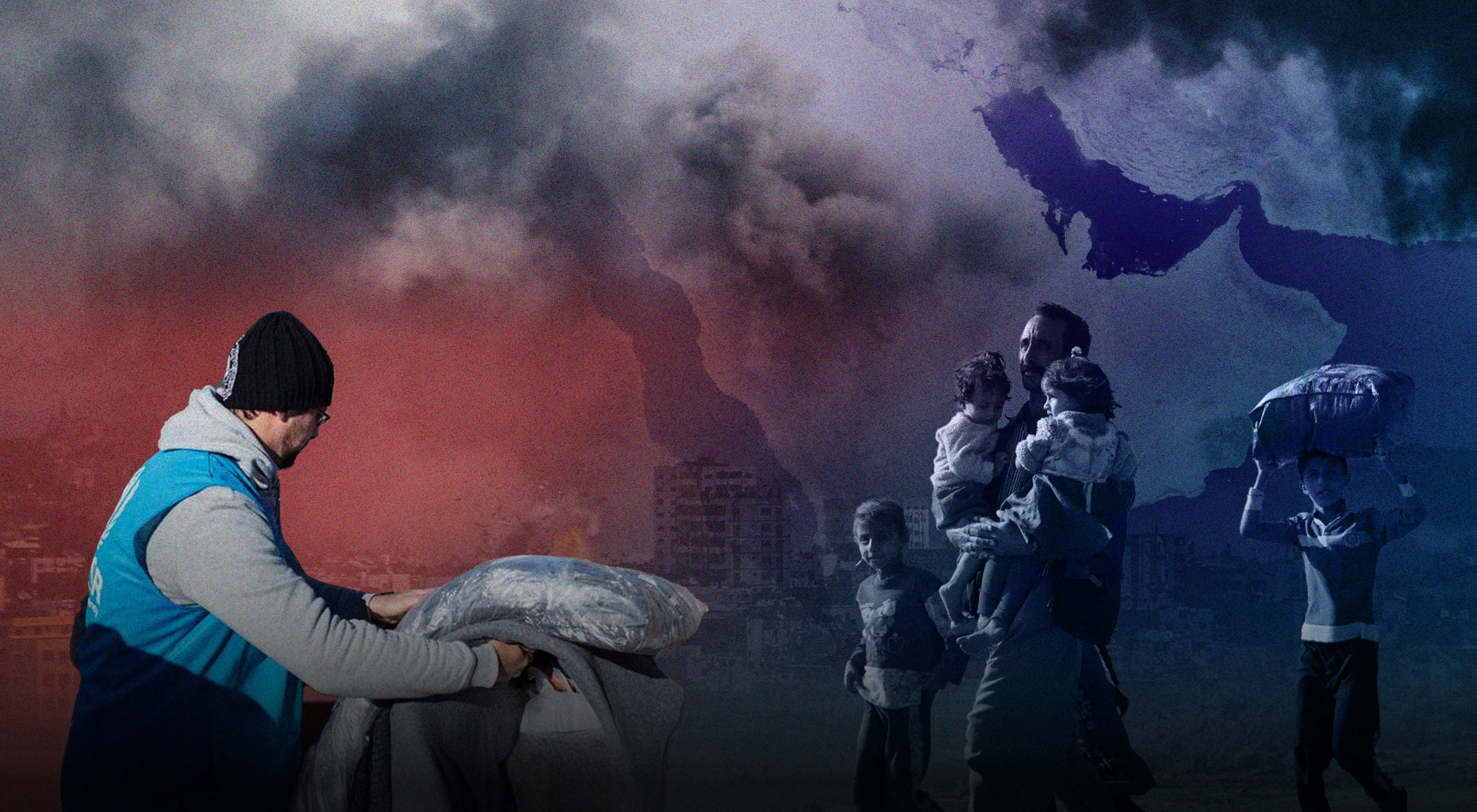The end of the largest armed conflict in Europe since World War II still seems far away. The main underlying cause of the breakout of the war from Moscow’s point of view was the threat perception from NATO’s expansion to the east and Ukraine’s mistreatment of its Russian population. Emboldened by the U.S./EU support to hold ground, Ukraine saw such intervention from Moscow in its internal affairs as an act of aggression and defied pressures to succumb to changes in its policies.
What started with Russia’s annexation of Crimea in 2014 and continued with proxy warfare in the Donbas region escalated into an all-out war in February 2022, claiming nearly half a million casualties. A massive dislocation of people has taken place in Ukraine, as 5.1 million people were internally displaced and 6.2 million Ukrainians have left the country, according to the UNHCR.[1]
Worse yet, more than 17 million people need humanitarian assistance inside Ukraine today. The country has suffered documented damage of more than US$150.5 billion (undocumented estimates are currently over US$200 billion).[2] In March 2023, a joint assessment by the Ukrainian government, the World Bank, European Commission, and the UN estimated that reconstructing Ukraine over the next ten years would cost US$411 billion.[3] Russian attacks are expected to exert more pressure on Ukraine’s GDP, adding an estimated drop of 2% in 2023 from the targeted 5% growth.
On a strategic level, although Ukrainian forces held their positions and continued surgical counteroffensive operations along the 1000km frontline using Western-supplied advanced weapons, progress has been limited. Improved Russian defenses proved effective, and any momentum created in the south and east has run out of steam.[4] Since June 2023, Ukrainian forces have advanced only 15km, most notably on the east bank of the Dnipro River in Kherson, while the Russian army has kept most of its gains.
As the winter approaches, the balance of power in land warfare favors the defendant (Russia) of occupied territories and not the attacker (Ukraine). Perhaps Ukraine’s most notable success was to knock out a significant number of Russian naval units and to debilitate shipyards, including its flagship of the Black Sea fleet – the Slava-class Moskva guided-missile destroyer – and the naval base in Sevastopol, by using a combination of unmanned vehicles and missiles that crippled Moscow’s ability to project power effectively at sea.
As losses on both sides mounted, many countries tried unsuccessfully to mediate a ceasefire on numerous occasions and met with cold shoulders due to a complex set of factors including cost/benefit calculations, reputation, political capital, and the influence of third-party stakeholders. Disinformation also played a major role in the war of competing narratives, where each side portrayed the ongoing conflict in their own terms to manipulate the public opinion and decisions of their interlocutors.
More recently, the grinding war of attrition that occupied news headlines for much of 2022-2023 has lost momentum due to war fatigue and hostilities in the Israel-Gaza front that diverted resources and attention to rising tensions in the Middle East. As the situation worsens for Ukraine, it hastily tries to maintain sympathy and support across the world in order to bring Russia to the table while the conditions are still favorable toward Kyiv for a political settlement. Ukraine’s 10-point peace plan stands out in this context as one of the competing proposals tabled for a settlement since 2022.
Ukraine’s 10-point Peace Plan
In November 2022, Ukrainian President Volodymyr Zelensky rolled out a 10-point peace plan that called for, among other things, the withdrawal of Russian troops, the restoration of Ukraine’s territorial integrity, security guarantees for Ukraine in the Euro-Atlantic space, and the release of all prisoners and deportees by Russia.[5] The plan calls for the implementation of:
1. Radiation and nuclear safety, especially around
Zaporizhzhia power plant.
2. Food security,
including protecting and ensuring Ukraine’s grain exports.
3. Energy security, with
focus on price cap on Russian energy resources, as well as aiding
Ukraine with restoring its power infrastructure.
4. Release of all
prisoners and deportees, including war prisoners and children deported to
Russia.
5. Restoring Ukraine’s
territorial integrity and Russia reaffirming it according to the UN Charter.
6. Withdrawal of Russian
troops and cessation of hostilities.
7. Justice, including the
establishment of a special tribunal to prosecute Russian war crimes.
8. Prevention of ecocide, the
need for protection of environment, with a focus on demining and restoring
water treatment facilities.
9. Prevention of
escalation of conflict and building security architecture in the Euro-Atlantic
space, including guarantees for Ukraine.
10. Confirmation of the war’s end, including a document signed by the involved parties.
The plan received mixed responses around the world: Russia rejected it, the G7 leaders reiterated their solidarity, while most leaders in the G20 called for an end to hostilities and offered support for peace efforts, choosing their words carefully not to explicitly condemn Russia. Ukraine has organized three summits since June 2022 to garner broader support from the international community for the peace plan and to put more pressure on Russia to agree to its terms.
The first summit, held in Copenhagen, Denmark, last June, saw a gathering of 15 countries, including the European Union (EU), Turkey, Brazil, India, and Saudi Arabia. Notably absent in person were U.S. Representative Jake Sullivan, who joined by video, and China, which declined to attend due to challenges lying ahead in the peace process.[6] While all parties appreciated mediation initiatives and agreed on UN-based principles of territorial integrity and sovereignty, there was no concrete outcome.
The second summit, held in Jeddah, Saudi Arabia, last August, similarly ended without any breakthrough but saw 40 countries represented, including China, Japan, and Indonesia.[7] The third round was held in Malta this October, with around 60 countries, including the U.S., but not China this time. Despite Zelensky’s claim that the “conference has gone global,”[8] the reality says otherwise, as key parties were absent at the table.
This last round was expected to help gauge Kyiv and the West’s ability to drum up steady and broad support amid fears that the Gaza war, which continues to dominate headlines, might move the focus away from Ukraine.[9] It is also seen as a platform for Ukraine to make its case directly to countries that have remained neutral in Russia’s war, especially those in the Global South such as Turkey, Brazil, South Africa, and Egypt.
But no matter how many heads of state attend these summits, there is no chance of achieving a diplomatic outcome without firm support from China, let alone Russia itself. In fact, China’s 12-point proposal for a negotiated settlement to the war is still on the table and more countries might be warming to a constructive role for Beijing to end the war.
Perhaps more importantly, many countries in the South see hypocrisy in the Western response to the Gaza war, which sits in stark contrast to the case of Ukraine. The only tangible outcome for Ukraine’s future so far is a key report from the European Commission recommending the start of formal negotiations on accession to the EU.[10]
Prospects for a negotiated settlement in Ukraine
If only the war in Israel-Gaza had not broken out and European countries had a stronger, more coherent foreign policy, Russia could be persuaded to back down and accept at least some of the terms outlined in the 10-point plan. The stretch of U.S. resources over Europe, the Middle East, and the Asia-Pacific, divisions among European countries, and economic stagnation erode the West’s power in shoring up support for Ukraine. Ukraine can only hold out for so long if NATO discontinues sending supplies. There are signs of weakening support for Kyiv’s cause in Western capitals; at least some momentum is building quietly to bring parties back to the negotiation table.
Ukraine needs US$41 billion in financial aid in 2024 to close the gap in its fiscal budget, roughly the same as in 2023. But it now finds itself competing with Israel for much-needed U.S. and EU assistance and attention, to say nothing about the U.S. pivot to the Indo-Pacific and commitment to its allies there.[11] There are signs of economic stabilization in Ukraine with the return of displaced people and the resumption of businesses; however, serious economic problems remain, including annual inflation of around 11%, monthly budget deficits of over US$3 billion, and spiraling official debt.
According to a recent Reuters/Ipsos poll, U.S. public support for arming Ukraine has declined from 46% in May to 41% in October.[12] The Republican Party (“GOP”) dropped its support for Ukraine in the 45-day stopgap spending bill, which resulted in the U.S. Department of Defense (DoD) to “meter out its support to Ukraine”.[13] Amid concerns about having reached a stalemate in the war, U.S. and European officials have reportedly begun talking to the Ukrainian government behind closed doors about what possible peace negotiations with Russia might entail.[14] As Kyiv’s manpower declines and the room for maneuver narrows, it may have to make some difficult decisions in the spring of 2024.
Possible steps down the road
Inevitably some horse-trading will take place once parties get to the negotiation table, where Ukraine might eventually recuperate a small chunk of its territories, receive U.S. security guarantees for the part under Kyiv’s control, and embark on a roadmap for membership in NATO and the EU. Russia, in return, could accept to demilitarize territories it keeps in the Crimea and Donbas regions and pay war reparations for reconciliation.
In that scenario, NATO will have achieved its aim to limit Russian military presence in the Black Sea and set a bulwark against potential Russian expeditions in the Mediterranean. The U.S.’s interest is not only to weaken Russia “to the point that it could not undertake similar actions in the future”[15] but also to send a strong signal to its long-term rival, China, that any similar move to change the status quo in Taiwan will have harsh consequences. Washington would not want a negotiated deal in Ukraine to be interpreted as appeasement by China. U.S. President Joe Biden would want to make sure he scores points to take home ahead of the presidential elections in November 2024.
All this, as a first step, must bring NATO/Western countries together with the leading countries in the Global South around the same table. As argued earlier, the 10-point peace plan has little chance to succeed without involving China, if not Russia, in the talks. It may help increase Ukraine’s hand by garnering sympathy from countries around the world, but that won’t last for long as economic hurdles and geopolitical risks increase.
Both President Zelensky and President Putin are betting on a second winter of war to make their case with public opinion leaders and ensure their political survival at home. Unable to win the war on the battlefield, Putin tries to prolong it long enough to undermine Ukraine’s economy, demoralize the population through strikes on civilian infrastructure, and exhaust its partners in Europe/NATO. He will run in presidential elections next March and wants to leave his legacy on the war. Zelensky aims to be the heroic “savior” of his country from the Russian yoke and leave his mark on Ukraine’s turn toward the West, both in symbolism and substance.
In this tense situation, there is ever more need to be realistic and to let go of sunk costs. Kyiv’s interest is not to reach a frozen conflict, no matter what guarantees it receives from the West, but to put all its effort into maintaining the momentum of creating a positive atmosphere for a negotiated settlement with Russia. NATO’s expansion by accepting Finland into membership and offering acceptance to Sweden achieved its goal of avoiding further Russian incursions in Europe but the status quo in Ukraine is unsustainable. With neither side having achieved their maximalist goals through a decisive victory and Ukraine especially showing signs of exhaustion, this is no time for repeated trials and failures. There is long overdue time for a cool-headed reconsideration of feasible and durable options for a permanent settlement to this war of attrition or else risk losing relevance among competing priorities in a fast-evolving, multicentered world order.
End Notes
[1] “Ukraine Refugee Crisis: Aid, Statistics and News
| USA for UNHCR,” UNHCR: The UN Refugee Agency, July 2023,
https://www.unrefugees.org/emergencies/ukraine/.
[2] Ralph
Clem, Eric Herron, and Matthew Lantzy, “Rebuilding Ukraine’s Economy Starts
Now,” War on the Rocks (blog), October 12, 2023,
https://warontherocks.com/2023/10/rebuilding-ukraines-economy-starts-now/.
[3] “Updated
Ukraine Recovery and Reconstruction Needs Assessment,” European Commission,
March 23, 2023,
https://ec.europa.eu/commission/presscorner/detail/en/ip_23_1852.
[4] “How Ukraine’s Counteroffensive Has Struggled so far,”
Reuters, November 3, 2023, sec. Europe,
https://www.reuters.com/world/europe/how-ukraines-counteroffensive-has-struggled-so-far-2023-11-03/.
[5] “Explainer: What Is Zelenskiy’s 10-Point Peace
Plan?,” Reuters, December 28, 2022, sec. Europe,
https://www.reuters.com/world/europe/what-is-zelenskiys-10-point-peace-plan-2022-12-28/.
[6] “Copenhagen Meeting Helps Advance Ukraine ‘Peace
Summit’ Plan – EURACTIV.Com,” Euractiv (blog), June 27, 2023,
https://www.euractiv.com/section/global-europe/news/copenhagen-meeting-helps-advance-ukraine-peace-summit-plan/.
[7] “Peace Plan in Saudi Arabia: What Was Discussed
and What Was Achieved?,” Visit Ukraine, August 10, 2023, https://visitukraine.today/blog/2371/peace-plan-in-saudi-arabia-what-was-discussed-and-what-was-achieved.
[8] “Russia vs Ukraine: Peace Talks Open in Malta as
Zelensky Says His 10-Point Plan Has Gone ‘Global,’” WION (blog), October
30, 2023,
https://www.wionews.com/world/peace-talks-opened-in-malta-as-zelensky-says-his-10-point-peace-plan-has-gone-global-652548.
[9] “Malta Expects More than 50 Countries for Third
Round of Ukraine Peace Talks – EURACTIV.Com,” Euractive (blog), October
28, 2023,
https://www.euractiv.com/section/europe-s-east/news/malta-expects-more-than-50-countries-for-third-round-of-ukraine-peace-talks/.
[10] “Enlargement: Commission Recommends Starting
Accession Negotiations with Ukraine, Moldova, Bosnia and Herzegovina, and
Candidate Status for Georgia,” European Commission, November 8, 2023,
https://commission.europa.eu/news/enlargement-commission-recommends-starting-accession-negotiations-ukraine-moldova-bosnia-and-2023-11-08_en.
[11] Iliya
Kusa, “What Does the Conflict in the Middle East Mean for Ukraine?,” Carnegie
Endowment for International Peace (blog), November 8, 2023,
https://carnegieendowment.org/politika/90945.
[12] Jason
Lange and Patricia Zengerle, “US Public Support Declines for Arming Ukraine,
Reuters/Ipsos Poll Shows,” Reuters, October 5, 2023, sec. United States,
https://www.reuters.com/world/us/us-public-support-declines-arming-ukraine-reutersipsos-2023-10-05/.
[13] “DOD
Implores Congress to Provide Ukraine Defense Funding,” U.S. Department of
Defense, November 9, 2023,
https://www.defense.gov/News/News-Stories/Article/Article/3585998/dod-implores-congress-to-provide-ukraine-defense-funding/https%3A%2F%2Fwww.defense.gov%2FNews%2FNews-Stories%2FArticle%2FArticle%2F3585998%2Fdod-implores-congress-to-provide-ukraine-defense-funding%2F.
[14] “U.S.,
European Officials Broach Topic of Peace Negotiations with Ukraine, Sources
Say,” NBC News (blog), November 4, 2023,
https://www.nbcnews.com/news/world/us-european-officials-broach-topic-peace-negotiations-ukraine-sources-rcna123628.
[15] Stephen M. Walt, “The World Won’t Be the Same
After the Israel-Hamas War,” Foreign Policy (blog), November 8, 2023,
https://foreignpolicy.com/2023/11/08/israel-hamas-gaza-war-geopolitics/.









